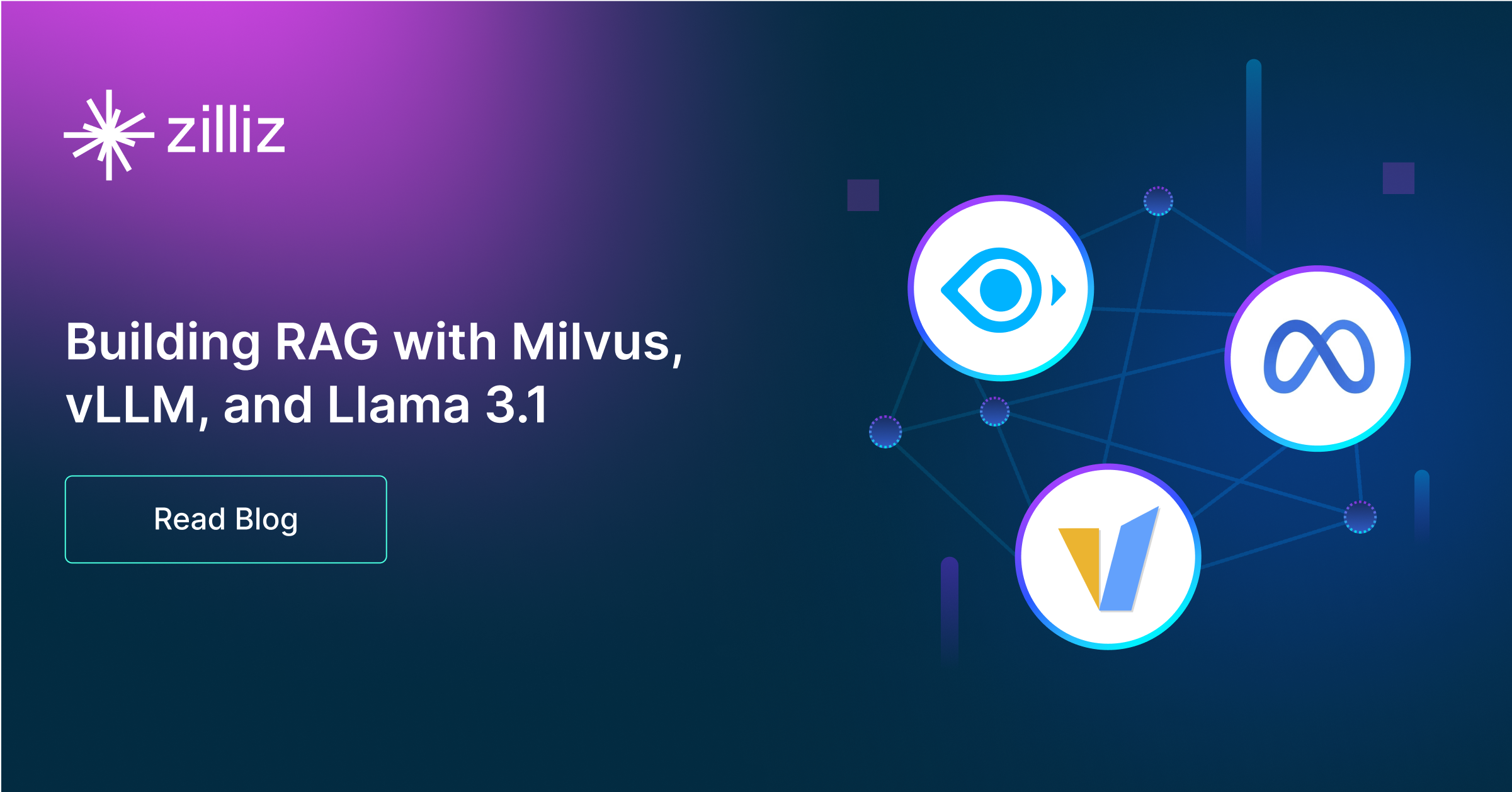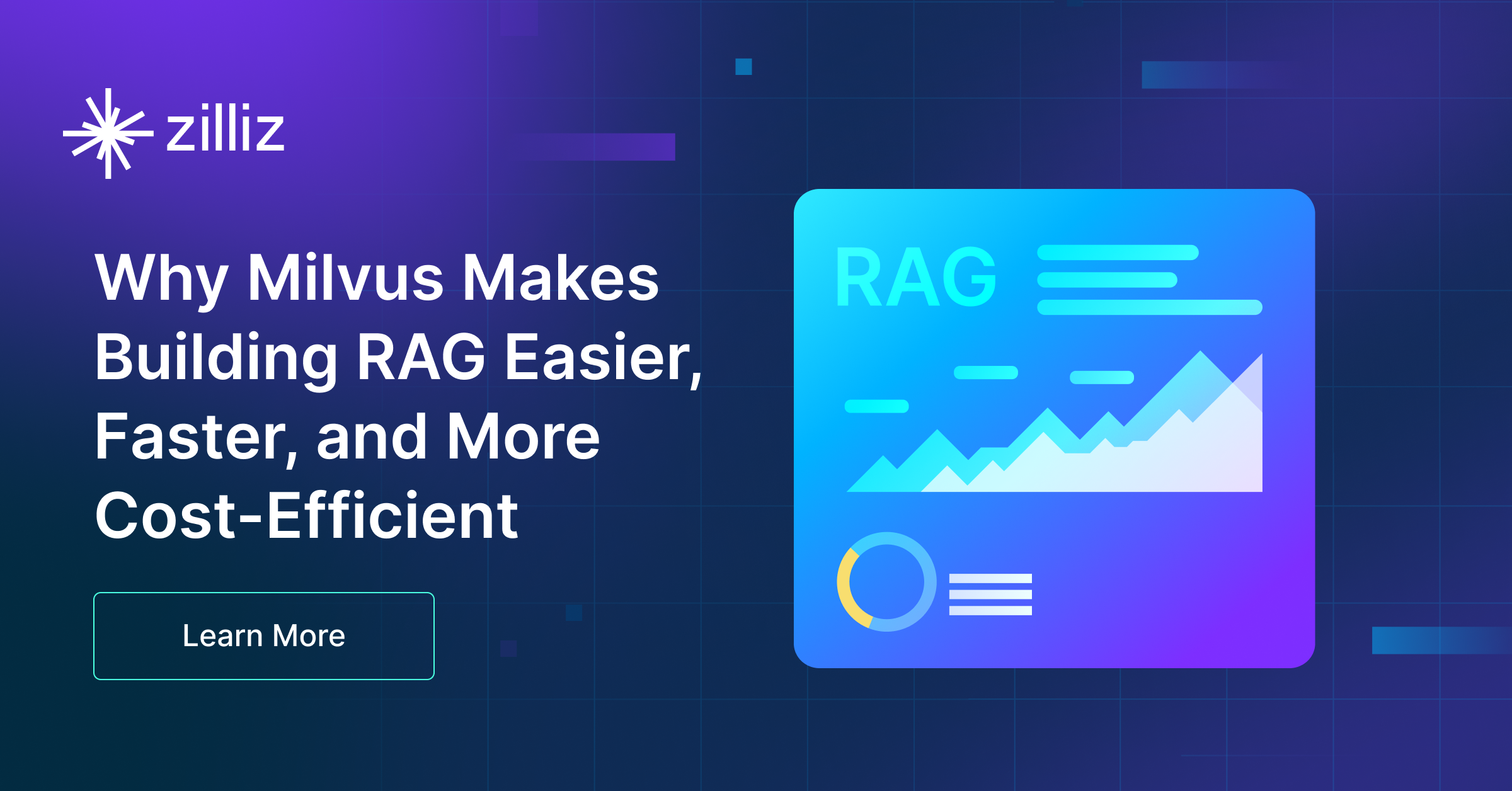Build RAG Chatbot with LangChain, Zilliz Cloud, NVIDIA Deepseek R1, and IBM all-minilm-l12-v2
Introduction to RAG
Retrieval-Augmented Generation (RAG) is a game-changer for GenAI applications, especially in conversational AI. It combines the power of pre-trained large language models (LLMs) like OpenAI’s GPT with external knowledge sources stored in vector databases such as Milvus and Zilliz Cloud, allowing for more accurate, contextually relevant, and up-to-date response generation. A RAG pipeline usually consists of four basic components: a vector database, an embedding model, an LLM, and a framework.
Key Components We'll Use for This RAG Chatbot
This tutorial shows you how to build a simple RAG chatbot in Python using the following components:
- LangChain: An open-source framework that helps you orchestrate the interaction between LLMs, vector stores, embedding models, etc, making it easier to integrate a RAG pipeline.
- Zilliz Cloud: a fully managed vector database-as-a-service platform built on top of the open-source Milvus, designed to handle high-performance vector data processing at scale. It enables organizations to efficiently store, search, and analyze large volumes of unstructured data, such as text, images, or audio, by leveraging advanced vector search technology. It offers a free tier supporting up to 1 million vectors.
- NVIDIA Deepseek R1: This advanced AI model is designed for high-fidelity image synthesis and enhancement, leveraging NVIDIA’s cutting-edge graphics technology. With its ability to generate realistic visuals and improve image quality, Deepseek R1 is ideal for applications in gaming, film production, and virtual reality, where lifelike graphics are paramount.
- IBM all-minilm-l12-v2: This model is a compact yet powerful transformer-based architecture optimized for natural language understanding and processing tasks. It excels in scenarios requiring efficient computation without sacrificing performance, making it ideal for applications in chatbots, information retrieval, and sentiment analysis. Its lightweight design enables integration in resource-constrained environments while maintaining competitive accuracy.
By the end of this tutorial, you’ll have a functional chatbot capable of answering questions based on a custom knowledge base.
Note: Since we may use proprietary models in our tutorials, make sure you have the required API key beforehand.
Step 1: Install and Set Up LangChain
%pip install --quiet --upgrade langchain-text-splitters langchain-community langgraph
Step 2: Install and Set Up NVIDIA Deepseek R1
pip install -qU "langchain-nvidia-ai-endpoints"
import getpass
import os
if not os.environ.get("NVIDIA_API_KEY"):
os.environ["NVIDIA_API_KEY"] = getpass.getpass("Enter API key for NVIDIA: ")
from langchain.chat_models import init_chat_model
llm = init_chat_model("deepseek-ai/deepseek-r1", model_provider="nvidia")
Step 3: Install and Set Up IBM all-minilm-l12-v2
pip install -qU langchain-ibm
import getpass
import os
if not os.environ.get("WATSONX_APIKEY"):
os.environ["WATSONX_APIKEY"] = getpass.getpass("Enter API key for IBM watsonx: ")
from langchain_ibm import WatsonxEmbeddings
embeddings = WatsonxEmbeddings(
model_id="sentence-transformers/all-minilm-l12-v2",
url="https://us-south.ml.cloud.ibm.com",
project_id="<WATSONX PROJECT_ID>",
)
Step 4: Install and Set Up Zilliz Cloud
pip install -qU langchain-milvus
from langchain_milvus import Zilliz
vector_store = Zilliz(
embedding_function=embeddings,
connection_args={
"uri": ZILLIZ_CLOUD_URI,
"token": ZILLIZ_CLOUD_TOKEN,
},
)
Step 5: Build a RAG Chatbot
Now that you’ve set up all components, let’s start to build a simple chatbot. We’ll use the Milvus introduction doc as a private knowledge base. You can replace it with your own dataset to customize your RAG chatbot.
import bs4
from langchain import hub
from langchain_community.document_loaders import WebBaseLoader
from langchain_core.documents import Document
from langchain_text_splitters import RecursiveCharacterTextSplitter
from langgraph.graph import START, StateGraph
from typing_extensions import List, TypedDict
# Load and chunk contents of the blog
loader = WebBaseLoader(
web_paths=("https://milvus.io/docs/overview.md",),
bs_kwargs=dict(
parse_only=bs4.SoupStrainer(
class_=("doc-style doc-post-content")
)
),
)
docs = loader.load()
text_splitter = RecursiveCharacterTextSplitter(chunk_size=1000, chunk_overlap=200)
all_splits = text_splitter.split_documents(docs)
# Index chunks
_ = vector_store.add_documents(documents=all_splits)
# Define prompt for question-answering
prompt = hub.pull("rlm/rag-prompt")
# Define state for application
class State(TypedDict):
question: str
context: List[Document]
answer: str
# Define application steps
def retrieve(state: State):
retrieved_docs = vector_store.similarity_search(state["question"])
return {"context": retrieved_docs}
def generate(state: State):
docs_content = "\n\n".join(doc.page_content for doc in state["context"])
messages = prompt.invoke({"question": state["question"], "context": docs_content})
response = llm.invoke(messages)
return {"answer": response.content}
# Compile application and test
graph_builder = StateGraph(State).add_sequence([retrieve, generate])
graph_builder.add_edge(START, "retrieve")
graph = graph_builder.compile()
Test the Chatbot
Yeah! You've built your own chatbot. Let's ask the chatbot a question.
response = graph.invoke({"question": "What data types does Milvus support?"})
print(response["answer"])
Example Output
Milvus supports various data types including sparse vectors, binary vectors, JSON, and arrays. Additionally, it handles common numerical and character types, making it versatile for different data modeling needs. This allows users to manage unstructured or multi-modal data efficiently.
Optimization Tips
As you build your RAG system, optimization is key to ensuring peak performance and efficiency. While setting up the components is an essential first step, fine-tuning each one will help you create a solution that works even better and scales seamlessly. In this section, we’ll share some practical tips for optimizing all these components, giving you the edge to build smarter, faster, and more responsive RAG applications.
LangChain optimization tips
To optimize LangChain, focus on minimizing redundant operations in your workflow by structuring your chains and agents efficiently. Use caching to avoid repeated computations, speeding up your system, and experiment with modular design to ensure that components like models or databases can be easily swapped out. This will provide both flexibility and efficiency, allowing you to quickly scale your system without unnecessary delays or complications.
Zilliz Cloud optimization tips
Optimizing Zilliz Cloud for a RAG system involves efficient index selection, query tuning, and resource management. Use Hierarchical Navigable Small World (HNSW) indexing for high-speed, approximate nearest neighbor search while balancing recall and efficiency. Fine-tune ef_construction and M parameters based on your dataset size and query workload to optimize search accuracy and latency. Enable dynamic scaling to handle fluctuating workloads efficiently, ensuring smooth performance under varying query loads. Implement data partitioning to improve retrieval speed by grouping related data, reducing unnecessary comparisons. Regularly update and optimize embeddings to keep results relevant, particularly when dealing with evolving datasets. Use hybrid search techniques, such as combining vector and keyword search, to improve response quality. Monitor system metrics in Zilliz Cloud’s dashboard and adjust configurations accordingly to maintain low-latency, high-throughput performance.
NVIDIA Deepseek R1 optimization tips
To optimize the NVIDIA Deepseek R1 for Retrieval-Augmented Generation (RAG), ensure that your input data is well-prepared and indexed for fast access, leveraging its caching capabilities. Utilize mixed-precision training to enhance performance while reducing memory usage, and experiment with different batch sizes to find the most efficient processing speed. Additionally, regularly monitor and fine-tune hyperparameters such as learning rate and dropout rates based on validation results to avoid overfitting. Implement asynchronous data loading to keep the GPU actively processing while managing I/O operations. Finally, streamline the architecture by pruning non-essential layers and optimizing the model's inference pipeline to enhance real-time retrieval performance.
IBM all-minilm-l12-v2 optimization tips
To optimize the IBM all-minilm-l12-v2 model in a Retrieval-Augmented Generation (RAG) setup, consider fine-tuning it on domain-specific datasets to enhance relevance and accuracy for your particular use case. Implement model distillation techniques to reduce inference time while maintaining performance. Additionally, ensure efficient batch processing by adjusting the maximum sequence length based on your input data, and utilize mixed precision training to improve computational efficiency. Regularly evaluate the model's performance with various retrieval methods to identify the best combination and consider employing caching strategies for frequently accessed data to minimize latency. Finally, experiment with different hyperparameters, like learning rate and dropout rates, during fine-tuning to achieve optimal results.
By implementing these tips across your components, you'll be able to enhance the performance and functionality of your RAG system, ensuring it’s optimized for both speed and accuracy. Keep testing, iterating, and refining your setup to stay ahead in the ever-evolving world of AI development.
RAG Cost Calculator: A Free Tool to Calculate Your Cost in Seconds
Estimating the cost of a Retrieval-Augmented Generation (RAG) pipeline involves analyzing expenses across vector storage, compute resources, and API usage. Key cost drivers include vector database queries, embedding generation, and LLM inference.
RAG Cost Calculator is a free tool that quickly estimates the cost of building a RAG pipeline, including chunking, embedding, vector storage/search, and LLM generation. It also helps you identify cost-saving opportunities and achieve up to 10x cost reduction on vector databases with the serverless option.
 Calculate your RAG cost
Calculate your RAG cost
What Have You Learned?
By diving into this tutorial, you’ve learned how to combine powerful tools—LangChain, Zilliz Cloud, NVIDIA Deepseek R1, and the IBM all-minilm-l12-v2 embedding model—to create a fully functional RAG system from scratch! You now understand how LangChain acts as the glue, seamlessly connecting your vector database (Zilliz Cloud) to the LLM (NVIDIA Deepseek R1) and embedding model (IBM all-minilm-l12-v2). This integration lets you build a pipeline where unstructured data is transformed into searchable vectors, retrieved efficiently, and used to generate accurate, context-aware answers. You’ve seen firsthand how Zilliz Cloud’s lightning-fast indexing and querying capabilities pair with IBM’s lightweight but powerful embeddings to make retrieval both speedy and precise, while NVIDIA’s LLM handles complex reasoning to deliver human-like responses. Plus, you picked up pro tips for optimizing performance, like tuning chunk sizes and filtering metadata, and even discovered how to estimate costs with the free RAG cost calculator—ensuring your projects stay budget-friendly as they scale.
This tutorial didn’t just teach you steps; it opened a door to building smarter AI applications. You’ve got the tools to turn raw data into dynamic, knowledge-driven solutions—whether for chatbots, research assistants, or enterprise search systems. The best part? You’re now equipped to experiment, tweak, and innovate. Maybe you’ll enhance retrieval accuracy with hybrid search strategies or fine-tune the LLM for your niche domain. Whatever you choose, remember: every optimization you apply and every feature you add brings you closer to creating something truly impactful. So fire up your IDE, play with these tools, and let your creativity run wild. The future of AI-powered applications is yours to shape—start building, keep iterating, and watch your ideas come to life! 🚀
Further Resources
🌟 In addition to this RAG tutorial, unleash your full potential with these incredible resources to level up your RAG skills.
- How to Build a Multimodal RAG | Documentation
- How to Enhance the Performance of Your RAG Pipeline
- Graph RAG with Milvus | Documentation
- How to Evaluate RAG Applications - Zilliz Learn
- Generative AI Resource Hub | Zilliz
We'd Love to Hear What You Think!
We’d love to hear your thoughts! 🌟 Leave your questions or comments below or join our vibrant Milvus Discord community to share your experiences, ask questions, or connect with thousands of AI enthusiasts. Your journey matters to us!
If you like this tutorial, show your support by giving our Milvus GitHub repo a star ⭐—it means the world to us and inspires us to keep creating! 💖
- Introduction to RAG
- Key Components We'll Use for This RAG Chatbot
- Step 1: Install and Set Up LangChain
- Step 2: Install and Set Up NVIDIA Deepseek R1
- Step 3: Install and Set Up IBM all-minilm-l12-v2
- Step 4: Install and Set Up Zilliz Cloud
- Step 5: Build a RAG Chatbot
- Optimization Tips
- RAG Cost Calculator: A Free Tool to Calculate Your Cost in Seconds
- What Have You Learned?
- Further Resources
- We'd Love to Hear What You Think!
Content
Vector Database at Scale
Zilliz Cloud is a fully-managed vector database built for scale, perfect for your RAG apps.
Try Zilliz Cloud for Free


